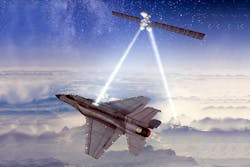L3Harris moves forward on satellite communications (SATCOM) using commercial internet for military aircraft
WRIGHT-PATTERSON AFB, Ohio – Space communications experts at L3Harris Technologies - C5 Integrated Systems in Camden, N.J., will help the U.S. Air Force capitalize on commercial space internet satellites to develop a new lightweight communications terminals for military aircraft.
Officials of the Air Force Research Laboratory at Wright-Patterson Air Force Base, Ohio, announced an $89.4 million follow-on order to L3Harris late last month for the Defense Experimentation Using Commercial Space Internet (DEUCSI) project.
L3Harris engineers will establish the ability to communicate with military platforms through multiple commercial space internet constellations.
The DEUCSI project seeks to develop small and lightweight satellite communications (SATCOM) systems that use commercial space internet constellations that easily integrate onto aircraft.
These airborne SATCOM systems will provide resilient, high throughput, globally available, and reliable communications using commercial internet satellites that operate in low, medium, and geostationary Earth orbits.
L3Harris won an original $80.8 million DEUCSI contract last May. Other DEUCSI contractors are Intelsat General Communications LLC in McLean, Va.; the Raytheon Technologies Corp. (RTX) Raytheon segment in McKinney, Texas; the Northrop Grumman Mission Systems segment in San Diego; the Lockheed Martin Aeronautics segment in Fort Worth, Texas; and Ball Aerospace & Technologies Corp. in Boulder, Colo.
DEUCSI seeks to find new ways of distributing information among land, sea, and air forces quickly to support high-speed decision-making by moving and sharing data seamlessly among fixed and mobile operating locations using constantly available, high-bandwidth, beyond-line-of-sight communications.
Related: Eyes in the sky - today's military SATCOM
DEUCSI space-based capability will be called path-agnostic communications because its users will be able to communicate reliably to any location in the world without explicitly specifying which nodes of a communication network to use.
The vision for path-agnostic communications is becoming possible due to the burgeoning commercial space industry, Air Force officials say. Several commercial companies plan to establish space internet constellations consisting of hundreds to thousands of commercial satellites, each to create global internet services.
This approach differs radically from traditional military satellite communications programs in which the government typically specifies and funds every aspect of the program, Air Force researchers point out.
Instead, taking advantage of the commercial space internet will concentrate government efforts on the few areas that are unique to Air Force applications.
The project has three phases: establish connectivity between several Air Force sites using commercial demonstration satellites and terminals; expand connectivity to many Air Force assets by proliferating user terminals to several locations and vehicle types; and special experiments to address military-unique requirements not otherwise met by commercial space internet vendors.
On this order L3Harris will do the work in Salt Lake City, and should be finished by August 2026. For more information contact L3Harris C5 Integrated Systems online at www.l3harris.com/capabilities/defense.
About the Author
John Keller
Editor-in-Chief
John Keller is the Editor-in-Chief, Military & Aerospace Electronics Magazine--provides extensive coverage and analysis of enabling electronics and optoelectronic technologies in military, space and commercial aviation applications. John has been a member of the Military & Aerospace Electronics staff since 1989 and chief editor since 1995.
